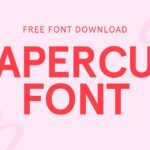The Salt and Sanctuary Font is a highly stylized, gothic-inspired typeface that evokes a dark, atmospheric fantasy world. This guide will help you understand its key characteristics, suggest design applications, and offer font pairing ideas to capture a similar mood in your own projects.
Ever stumbled across a game, website, or design that immediately pulled you into its world with just the words? That’s the magic of a well-chosen font. Sometimes, a specific font becomes so tied to a piece of media, like the unique “Salt and Sanctuary Font,” that it instantly sparks recognition and a desired mood. If you’re looking to infuse your own creations with that same dark, atmospheric, and slightly mysterious vibe, you’re in the right place! It can feel a bit daunting to figure out exactly what makes a font work or how to pair it effectively. But don’t worry, we’re going to break down the Salt and Sanctuary Font’s style so you can confidently use it (or fonts like it!) in your next project. Let’s dive into creating something truly captivating!
Understanding the Salt and Sanctuary Font: Core Characteristics
The “Salt and Sanctuary Font” isn’t just a choice; it’s a statement. For those unfamiliar, Salt and Sanctuary is a notoriously challenging and atmospheric action RPG. Its visual identity, including its typography, plays a huge role in immersing players in its grim, hand-drawn, dark fantasy world. When we talk about the Salt and Sanctuary Font, we’re generally referring to the distinctive, often gothic or medieval-inspired lettering used in the game’s title and promotional materials. It’s crucial to understand that while there might not be one single, officially named “Salt and Sanctuary Font” available for public download with that exact name, the style it represents is very recognizable.
This style typically embodies:
- Gothic and Medieval Influences: Think sharp serifs, dramatic flourishes, and an overall sense of ancient craftsmanship.
- Dark and Atmospheric Feel: The font often evokes a sense of mystery, danger, and a deep, shadowy world.
- Hand-Drawn or Textured Quality: Many iterations of this style have a slightly rough, imperfect, or textured look, mirroring the game’s distinctive art style.
- Readability Challenges (in high doses): While striking for titles, highly decorative fonts like this can be difficult to read in long blocks of text.
Understanding these core elements is your first step to either finding a font that perfectly matches this aesthetic or using one with a similar spirit. It’s about capturing not just the look, but the feeling.
When to Use a “Salt and Sanctuary” Style Font
This type of font isn’t an everyday workhorse. Its strong personality means it shines brightest when used strategically. Think of it as a special ingredient that adds a unique flavor to your design, rather than the main course itself.
Ideal Use Cases:
- Game Titles and Branding: This is where the style truly excels. If you’re developing a game, app, or creative project within the dark fantasy, gothic, or medieval genres, this font style is a natural fit.
- Event Invitations: For themed parties, gothic weddings, or Halloween events, this font can set a wonderfully spooky or dramatic tone right from the invitation.
- Book Covers and Headers: For novels falling into dark fantasy, horror, or historical fiction genres, a strong title font can instantly communicate the book’s theme.
- Posters and Promotional Materials: For concerts, movie releases, or art exhibits with a similar mood, this font can grab attention and convey the atmosphere.
- Logos for Niche Brands: Businesses that want to project an image of tradition, artisanal quality, mystery, or a connection to the past might find this style appealing for their logo.
When to Be Cautious:
While powerful, these fonts aren’t always the best choice:
- Body Text: Long passages in a highly decorative font can strain the eyes and be very difficult to read.
- Modern or Minimalist Designs: This style clashes with clean, contemporary aesthetics.
- High-Accessibility Needs: For interfaces or materials where maximum readability for all users is paramount, opt for simpler fonts.
The key is to use these fonts as accents, drawing the eye and setting a mood, rather than for extended reading.
Finding Fonts with the Salt and Sanctuary Vibe
Since there isn’t one definitive “Salt and Sanctuary Font” widely available, the trick is to find fonts that capture its essence. We’re looking for typefaces that share those gothic, dark, and atmospheric qualities. Many fonts inspired by historical scripts or dark fantasy art will fit the bill. Here’s how to approach your search and some categories to explore:
Key Font Categories to Explore:
- Gothic/Blackletter Fonts: This is the most direct route. Think Fraktur, Textura, or Old English styles. They are characterized by their dense, angular strokes and often elaborate swashes.
- Medieval-Inspired Fonts: These fonts often draw from illuminated manuscripts or historical signage. They can range from more legible, sturdy styles to highly decorative ones.
- Fantasy Display Fonts: The realm of fantasy gaming and literature has spawned countless display fonts designed to evoke magic, adventure, and the epic. Many of these tap into dark, ancient aesthetics.
- Distressed or Textured Fonts: Fonts that have a deliberately rough, worn, or ink-bled appearance can strongly complement the hand-drawn feel of the Salt and Sanctuary aesthetic.
Where to Search:
Numerous online font repositories offer a vast selection. When browsing, use keywords like “gothic,” “blackletter,” “medieval,” “fantasy,” “dark,” “display,” and “script” (though be mindful that “script” can also mean cursive, so look for styles that fit the mood). Some popular platforms include:
- Google Fonts (offers many free options, though fewer with this specific dark fantasy vibe)
- Adobe Fonts (included with Creative Cloud subscriptions)
- MyFonts
- Fontspring
- DaFont (has many free options, but check licenses carefully)
When you find a font, look at its sample characters, read its description, and check out the designer’s other works. Often, a designer who creates one good gothic font will have others that fit a similar theme.
Essential Style Guide: Crafting Your Design
Once you’ve found a font that captures the Salt and Sanctuary spirit, using it effectively is key. It’s not just about picking the font; it’s about how you implement it. Think of it as composing a piece of music or painting a scene – the font is one instrument or color, but it needs to work within a larger composition.
1. The Power of Display: Titles and Headlines
This is where your chosen font will make the biggest impact. Use it for:
- Main Title/Logo: The most prominent use. Ensure it’s legible even at a distance.
- Section Headers: Use sparingly to break up content and add thematic flair.
- Key Quotes: Highlight impactful lines of dialogue or text.
Tips for Display Use:
- Kerning and Spacing: Pay close attention to the space between letters (kerning) and words. These fonts can sometimes have unpredictable spacing, so manual adjustments might be necessary for a polished look.
- Letter Case: Uppercase often works best for these strong, impactful styles, but experiment with Title Case if it fits the design.
- Size Matters: Ensure the font is large enough to be appreciated for its detail and style.
2. Pairing for Readability: The Supporting Cast
Since these dramatic fonts are usually not ideal for body text, you’ll need complementary fonts. The goal is to create contrast and hierarchy while maintaining a cohesive mood.
Choosing Your Pairing Fonts:
Look for fonts that offer a different personality but a shared undertone:
- Simple Sans-Serifs: A clean, modern sans-serif can provide excellent readability and a stark contrast that makes your display font pop. Think fonts like Lato, Open Sans, or Montserrat for a more neutral feel.
- Subtle Serifs: If you want to lean into a more classic or historical feel, a legible serif font with minimal ornamentation can work well. Consider Garamond, Merriweather, or Lora.
- Monospaced Fonts: For a more technical or “coded” feel, a monospaced font can offer a unique contrast.
Example Pairing Strategy:
Let’s say you pick a bold Blackletter font for your title. For the subtitle, you might use a slightly more readable, but still somewhat stylized, serif. And for any explanatory text or longer descriptions, a clean, highly legible sans-serif would be your best bet.
3. Color and Texture: Enhancing the Atmosphere
The color palette and any textural elements you use will significantly influence the overall mood. For a Salt and Sanctuary-esque feel:
- Color Palette: Think deep, muted tones. Blacks, charcoal grays, deep blues, forest greens, blood reds, and earthy browns are excellent choices. Consider metallic accents like aged gold or tarnished silver for a touch of dark opulence.
- Contrast is Key: Ensure your chosen font stands out against its background, especially if you’re using dark colors. For example, a dark gothic font on a black background will need a subtle outline, drop shadow, or a lighter background variant to be readable.
- Textures: Incorporating textures like parchment, aged paper, distressed metal, or rough stone can amplify the atmospheric quality of your design. This could be a background image or a Photoshop overlay.
4. Layout and Composition: The Stage for Your Font
How you arrange elements on your page or screen is crucial. Avoid clutter.
- White Space (or Dark Space): Give your dramatic font room to breathe. Ample negative space (or dark, atmospheric space) draws attention to the important elements and prevents the design from feeling overwhelming.
- Hierarchy: Clearly define what’s most important. Your main title should be the largest and most prominent, with supporting text progressively smaller and less visually dominant.
- Alignment: Consistent alignment (centered, left-aligned) helps create a sense of order, even within a dark or chaotic theme.
Practical Application: A Case Study
Let’s imagine you’re designing a landing page for a new indie game that draws inspiration from Salt and Sanctuary. How would you apply these principles?
Scenario: Indie Game Landing Page
- Hero Section (Above the Fold):
- Game Title: Use your chosen gothic/blackletter font. Make it large, impactful, and perhaps slightly textured. Consider an aged gold color against a dark, moody background image of a desolate landscape.
- Tagline: A more readable, but still stylized, serif font. Perhaps a deep crimson or stark white for contrast.
- Call to Action Button: A clean, simple sans-serif for immediate clarity (e.g., “Wishlist Now”).
- Below the Fold (Game Description):
- Section Headers (e.g., “Lore,” “Gameplay Features”): Could use the same stylized serif from the tagline, or a slightly bolder version of your main sans-serif.
- Body Text: A highly legible sans-serif font like Open Sans or Roboto. This ensures players can easily read about the game’s mechanics, story, and features without eye strain.
- Key Feature Callouts: Sometimes using the display font for a single keyword (e.g., “Souls-like” or “Bosses”) can be effective if done very sparingly.
Table: Font Pairing Recommendations
Here’s a quick reference for pairing your dramatic display font with more functional typefaces.
| Purpose | Font Style Category | Recommended Font Types | Example Fonts |
|---|---|---|---|
| Main Titles, Headlines, Logos | Gothic, Blackletter, Dark Fantasy Display | Highly decorative, angular, stylized | (Your chosen Salt & Sanctuary style font) |
| Subtitles, Quotes, Highlighted Text | Strong Serif or Moderate Display | Slightly stylized, readable, distinct from title font | Merriweather, Cormorant Garamond, Cinzel Decorative |
| Body Text, Paragraphs, Descriptions | Highly Readable Sans-Serif or Serif | Clean, legible, neutral | Open Sans, Lato, Roboto, Lora, Garamond |
| Call-to-Actions (Buttons, Links) | Functional Sans-Serif | Clear, modern, high contrast | Montserrat, Poppins, Lato |
Remember, the goal is contrast and hierarchy. Your main font should stand out, while your supporting fonts should ensure the content is accessible and enjoyable to read.
Resources for Further Exploration
To deepen your understanding and find excellent fonts, explore these resources:
- The Anatomy of a Font: Understanding basic typographic terms like serif, sans-serif, ascender, descender, and kerning will empower you. For a great overview from a university perspective, explore resources from type theory courses. Many university graphic design departments offer accessible online guides.
- Typography Blogs and Websites: Sites like Typophile (though archived, still a treasure trove of discussion) and Google Fonts themselves offer articles and inspiration.
- Font Pairing Tools: Websites like FontPair or Canva’s font pairing tool can offer suggestions, though they may not always hit the specific dark fantasy niche you’re looking for. Use them as a starting point.
- Design Communities: Engaging with communities on platforms like Behance or Dribbble can expose you to how other designers are using dramatic fonts effectively.
- Games with Strong Typography: Analyze the typography in other games that capture a similar dark fantasy or gothic mood. What fonts do they use? How are they paired?
By actively seeking out information and inspiration, you’ll become more adept at identifying and using fonts that perfectly match your design vision.
Frequently Asked Questions (FAQ)
Q1: Is there an official “Salt and Sanctuary Font” I can download?
While the game uses a distinctive style of lettering, there isn’t one single font officially named “Salt and Sanctuary Font” that’s widely available for public download. You’ll need to find fonts that emulate its gothic, dark, and atmospheric style.
Q2: Can I use a gothic font for my entire website?
It’s generally not recommended to use very decorative gothic or blackletter fonts for your website’s main body text. They can be very difficult to read for extended periods. They are best used for headlines, logos, or accent elements.
Q3: How do I make sure my chosen font is legible?
Look at its clarity at different sizes. Test it in paragraphs. Consider its x-height (the height of lowercase letters like ‘x’), and the spacing between letters. Fonts with simpler forms and open counters (the enclosed space in letters like ‘o’ or ‘p’) tend to be more readable.
Q4: What kind of projects are best suited for a “Salt and Sanctuary” style font?
This style is perfect for projects with a dark fantasy, gothic, medieval, horror, or historical theme. Think game logos, book covers, themed event materials, or dramatic posters. It’s for making a strong, atmospheric statement.
Q5: Where can I find free fonts that look like the Salt and Sanctuary Font?
Websites like DaFont, FontSpace, or even Google Fonts (using keywords like “gothic,” “blackletter,” “medieval”) offer many free options. Always check the license for free fonts to ensure you can use them for your intended purpose (e.g., commercial vs. personal projects).
Q6: How can I improve the spacing of a decorative font?
Most design software (like Adobe Photoshop, Illustrator, InDesign, or even Canva) allows you to adjust kerning (space between specific letter pairs) and tracking (overall letter spacing). For highly decorative fonts, manual kerning is often essential for a professional look.
Conclusion
The “Salt and Sanctuary Font” style is a powerful tool for evoking a specific mood – one of mystery, darkness, and ancient worlds. By understanding its core characteristics, identifying fonts that capture its essence, and applying them strategically, you can imbue your designs with that same captivating atmosphere. Remember to use these dramatic typefaces as accents, particularly for titles and headers, and pair them thoughtfully with highly readable fonts for any body text. Pay attention to color, texture, and layout to



